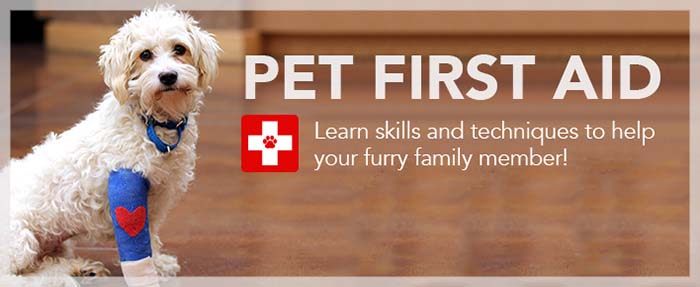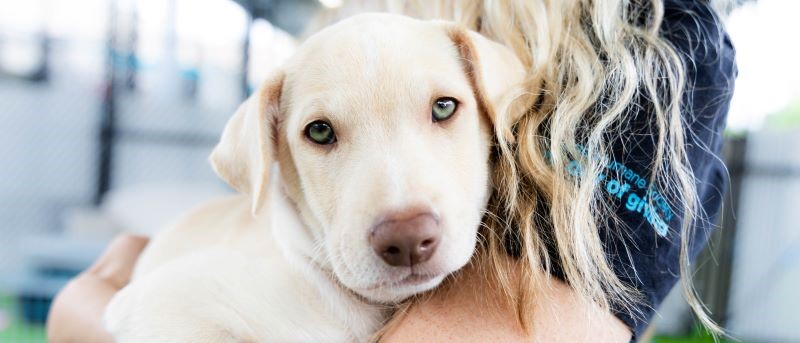First Aid Tips for Pet Owners

For most pet parents, first aid is a topic we don’t really think about until we find ourselves face-to-face with a pet emergency. The last thing you want is to be frazzled when your pet is relying on your swift thinking the most. Spare yourself (and your pet) the panic, by familiarizing yourself with what to do and where to go should your pet ever become unwell.
First, know where to go.
Make a list of veterinarians around your home. If there are other places you frequent with your pet, like the dog park or a particular hiking trail, make note of veterinarians in those areas as well. Be sure to include the hospital’s address, phone number and hours of operation. Also include a 24-hour emergency hospital in case your pet needs medical care on the weekends or after normal business hours.
Secondly, get educated.
The best thing you can do for your pet is acquire the knowledge needed to stabilize their condition. Pet first aid courses are usually offered locally and provide valuable training on how to treat minor wounds, bites, burns and other illnesses. This hands-on learning opportunity is truly the best way to prepare for handling a pet emergency.
In addition to taking a pet first aid course, here is a brief guide that can help you provide immediate triage care to a sick or injured animal.
- Injured paws: If you notice your pet limping or continuously licking a paw, turn the paw over and inspect it for a blister, abrasion or spur. Spurs can be carefully removed with tweezers or, depending on their size, by hand. For blisters and cuts, gently clean the treat the area with an antibacterial cleanser or ointment. Although bandages can be problematic for most animals, if your pet allows it, you can cover the area with gauze until it heals.
- Dangerous foods and materials: If you suspect your pet has consumed foods or substances that may be harmful, consult your veterinarian regardless of whether or not your pet is exhibiting any symptoms. If your pet’s body has been exposed to a chemical or poison, check the product labeling for how to treat affected areas. You can also reference the Pet Poison resource online at: http://www.petpoisonhelpline.com/poisons
- Bee stings: Pets will most likely be stung somewhere on the face or paw. If the stinger is still present, gently remove it by hand or using the edge of a business or credit card. For pain management, apply an ice pack or a light mixture of water and baking soda to the affected area. Some animals can have very serious allergic reactions to bee stings that can be life threatening. Take your pet to the hospital immediately if they have multiple stings to the tongue and throat area, or symptoms of an allergic reaction such as weakness, difficulty breathing, collapsing or excessive swelling away from the sting site.
- Cuts and abrasions: Press a thick, clean gauze pad over the wound and apply firm pressure to stop the bleeding. If bleeding persists heavily, a trip to the veterinarian may be required.
- Broken bone or torn ligament: Due to distress and pain, even the most social and friendly animals can show aggression in these instances to “protect” their injury. Proceed with extreme caution if your pet sustains a broken bone or torn ligament. Safely and carefully transport them hospital immediately.
- Seizures: Keep your pet on level ground – away from stairs and objects they could potentially hurt themselves on. Wrap them in a blanket and call your veterinarian immediately.
- Burns: Typically, burns don’t appear as severe as they truly are in dogs and cats. Additionally, they are usually painful and some animals may not allow the affected area to be touched or treated. It’s best to seek veterinary care for burns early on, so that the true severity of the injury can be professionally assessed and treated.
- Choking: If something becomes lodged in your pet’s airway, whether they are able to breath or not, take them to the hospital immediately.
Resource links:
https://www.akc.org/expert-advice/health/dog-first-aid-kit-essentials/
https://www.aspca.org/pet-care/animal-poison-control
https://www.avma.org/public/EmergencyCare/Pages/First-Aid-Tips-for-Pet-Owners.aspx
https://fluentwoof.com/first-aid-for-dogs/
Published: August 25, 2015








